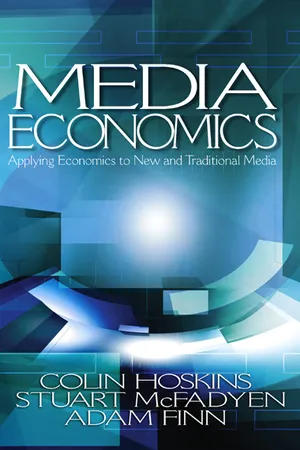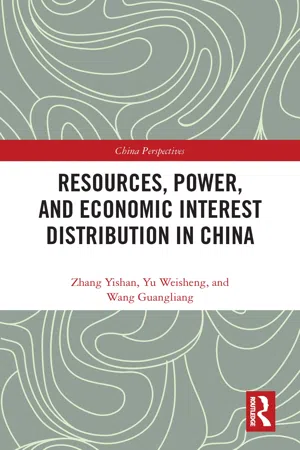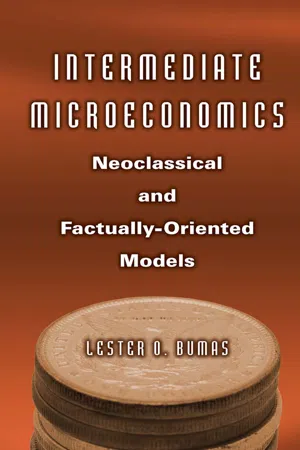Economics
Price Determination in a Competitive Market
Price determination in a competitive market is the process by which the interaction of supply and demand sets the equilibrium price for a good or service. In this market structure, numerous buyers and sellers have no individual influence over the market price, leading to a price that reflects the true value of the product and allocates resources efficiently.
Written by Perlego with AI-assistance
Related key terms
5 Key excerpts on "Price Determination in a Competitive Market"
- eBook - ePub
- Harlan M. Smith(Author)
- 2016(Publication Date)
- Routledge(Publisher)
Demand, Supply, Competition, Invisible Hand11. Price Determination
Students easily get the impression that the economist’s answer to any question is “demand and supply.” That is the answer usually given to the question of what determines individual prices. What really completes the answer is, of course, the analysis of what lies behind and determines both demand and supply conditions for different things priced.Some students may feel there is an elementary difficulty with the demand-and-supply story in that it is stated as though the mechanism operates untouched by human hands. Prices are said to be changed by changes in demand or supply. Of course, prices are set and changed by people as a result of decision-making processes in which people respond to some degree to what they perceive, rightly or wrongly, to be changes in some of the conditions that affect demands and supplies. A human role is recognized in the term “price-makers,” though the term “price-takers” seems to suggest absence of human intervention. It is explained that in the latter situation, an individual seller or buyer cannot effectively bargain over price since there are other buyers and sellers ready to complete transactions at a price that has been prevailing in the market. Older textbooks used to illustrate situations in which buyers and sellers could haggle and bargain over price within a range set by what each one was willing to do. In the imaginary perfectly competitive market situation, each side knows, or learns by experience, that the range shrinks to a single price. Apart from the two conditions just mentioned, bargaining and perfect competition, buyers decide whether to buy or not to buy at prices others have set. And the sellers, who are the price-makers (as the term goes, or price-searchers as others would call them), make decisions about prices to charge, based upon their estimates of demand and supply conditions. Presumably they learn by experience that, for any given demand and supply conditions, although they have power to vary price, there is only one price that will maximize their profits. That is how demand and supply, the latter usually implying cost conditions, determine price, not by magic but by human decisions as to prices. Of course, the textbook is talking primarily about equilibrium prices, those that equate quantity demanded and quantity supplied, not primarily about the market prices at any specific time when they may not be at an equilibrium. But even though all prices involve someone’s setting them according to some perceived conditions, even the monopolist seems “forced” to set the price that market and cost conditions dictate if the objective is profit maximization. - eBook - ePub
Media Economics
Applying Economics to New and Traditional Media
- Colin Hoskins, Stuart M. McFadyen, Adam Finn(Authors)
- 2004(Publication Date)
- SAGE Publications, Inc(Publisher)
1 . Equilibrium price is the only price for which demand and supply plans are compatible and thus sustainable.If the current price, such as P2 , is higher than the equilibrium price, there will be an excess supply, as the quantity supplied at this price is Q2 , whereas the quantity demanded is only Q0 . The excess supply is thus Q2 – Q0 . This will create a downward pressure on prices that will continue until P1 is established.If the current price, such as P0 , is lower than the equilibrium price, there will be an excess demand, as the quantity demanded at this price is Q2 , whereas the quantity supplied is only Q0 . The excess demand is thus Q2 – Q0 . This will create an upward pressure on price, which will continue until P1 is established. Price thus adjusts to effectively ration supply among consumers.Figure 2.5 Determination of Equilibrium PriceNote: D indicates demand curve; P, price; Q, quantity; S, supply curve. Note that for our example relating to the demand and supply for movie tickets, the equilibrium price would be $10. At a price of $10, the quantity demanded and quantity supplied are equal at 70,000.2.4 But Aren’t Prices Determined by Companies Rather Than by Supply and Demand?The answer to this question is that it depends on the industry structure. If the industry structure is one in which there are very many firms, each with an insignificant market share, producing identical products, and no barriers to entry by new firms (this industry structure is known as Perfect Competition), then market price is indeed determined by demand and supply and firms are price takers. This is the case for commodities such as gold and wheat. It appears computers are well on the way to becoming commodities.For most industries, even though companies have some degree of market power and set their own product price, the pressure of competition is sufficient to ensure that the price set by firms reflects the forces of supply and demand. In such cases, supply and demand analysis, as presented in this and the next chapter, provides important insights. Two examples illustrate this. The first relates to our movie seat example. Movie exhibition does not meet the criteria for Perfect Competition. Indeed, it is common to find exhibition dominated by a small number of chains, with some independent competition. Nevertheless, if exhibitors find that their theaters are often almost empty for matinee showings, they can be expected to cut back on the number of such showings and decrease price. This is precisely as predicted by supply and demand analysis. If they find their theaters are regularly overflowing, they will offer more showings, increase ticket prices, and, in the long run, build more cinemas—again, as predicted. Although exhibitors are not price takers, accepting a market price determined by the impersonal forces of supply and demand, their price changes will be consistent with supply and demand analysis. - Zhang Yishan, Yu Weisheng, Wang Guangliang(Authors)
- 2021(Publication Date)
- Routledge(Publisher)
The other reason that our analysis must begin with the transaction price is that the equilibrium price theory of new classical economics lacks operability. In fact, regardless of what type of goods market, it is difficult to determine whether the observed transaction price is the equilibrium price or fluctuates around the equilibrium price. This is the case even for the often quoted agricultural product market. Moreover, due to the openness of the market system, demand and supply in every market are affected by many factors and, consequently, continue to change. Before arriving at the market equilibrium price described by new classical theory, there are always some factors that cause the transaction price to deviate from the original locus of change and then converge toward the market equilibrium price. Such factors are the equilibrium path depicted in the cobweb model in perfect competitive market and the equilibrium path depicted in the dynamic matching model (Gale, 2000). The method used to study the transaction price does not have such ambiguity because we only need to show the reason why the transaction price between A and B is higher than the transaction price between A and C. Or, we can say that the object of our research is observable. The task for researchers is to explain the observed price and understand its determining factors. Such understanding is vital to theoretical researchers and the participants of economic activities because price is the signal that directs resource allocation and a mechanism that distributes economic interests under any market structure.The distribution function of price
For allocating resources to work, the premise regarding price is that all markets, including goods and factor markets, must be fully competitive. This is obviously an extreme assumption. If this assumption is not satisfied, it is pointless to discuss resource allocation. In a fully competitive market, what role does price play, and why do all the trading parties consider price to be the primary factor of concern?Setting aside the disputes and quarrels over concepts and theories, economic activities are actually quite basic. They can be summarized as efforts to seize resources, produce all types of products and services, and then to enjoy the achievements. Because everyone’s needs are diversified, self-sufficiency hinders the creation of wealth and economic development; therefore, labor division emerges. The division improves productivity, but it makes the exchange of products necessary. Consequently, prices emerge. A high price is favorable to sellers while a low price is favorable to buyers; therefore, price is essentially a type of interest distribution mechanism. Any change in price is a redistribution of interests. For example, in a simple two-person economy, A and B produce in their specialized areas, respectively. A produces 10 units of clothing and B does 10 units of food. We use an Edgeworth box to describe the relationship between them (as showed in Figure 5.1 ). In the figure, the horizontal axis represents the quantity of clothing while the vertical axis represents the quantity of food. OA is the coordinate origin of A. Any point to the right or above this origin indicates that A has more of both clothing and food. OB is the coordinate origin of B, and any point to the left or below this origin implies that B has more of both clothes and food. W represents the initial endowment of both parties when they first enter the market, which states that the initial endowment of A is 10 units of clothing and 0 unit of food while the initial endowment of B include 0 unit of clothing and 10 units of food. If the unit price is 1 yuan for both clothing and food, then the bundle of goods after the exchange will move along the line of WP1 . If the unit price is 1 yuan for clothing but 2 yuan for food, then the bundle will move along line WP2 . For any quantity that A is willing to give up (such as A is willing to give up 6 units of clothing), the bundle that resulted in the second price (clothing = 10−6 = 4 while food = 6 × 1/2 = 3 ) will be definitely inferior to that in the first price (clothing = 10−6 = 4, food = 6 × 1/1 = 6 ) — although it is always possible find a point on line WP2- eBook - ePub
- Paul Reynolds, Geoff Lancaster(Authors)
- 2005(Publication Date)
- Routledge(Publisher)
Consumers (both final consumers and other manufacturers) can easily compare selling prices, but this does not give any proper insight into competitive manufacturing pricing structures, as it relates to various members of the marketing channel. Buyers can compound this difficulty by ‘inventing’ ‘special prices’ and ‘non-existent discounts’, not really offered by competitors, but stated as being real during the negotiation process to help when bargaining for a lower price.When products are easily initiated and markets are relatively easy to enter, the price of existing or potential competitive products assumes major importance. Even when products have substantial distinctiveness, it is not usually too long before other companies will enter the market. Competition stems from three major sources:- ‘Head-on’ competition from directly similar products.
- Competition from substitute products.
- Competition from products that are not directly related, but which compete for the same disposable income. For instance, watch manufacturers are often in competition with fountain pen manufacturers because their products are often bought as gifts. Hand knitting is mainly a leisure activity, so yarn producers face competition from other ‘hand-craft’ hobbies to seek the potential customer’s free time. This aspect of competition is often overlooked when setting prices.
7.4.4 Market Share Analysis
If the company is seeking a significant market share, the price for the product will need to be competitive. Management should ensure that production capacity is sufficient to meet demand that this anticipated market share might create. If production capacity is limited, there is little point in setting low prices that might attract orders that cannot be fulfilled.The steps discussed so far in price determination have been concerned with the market place, rather than the internal workings of the firm. Market considerations should be the major determinant of price, so it would be illogical to develop a product whose price did not fall approximately in line with competitive prices. The level of potential demand at given price levels is, therefore, an important consideration. Marketers sometimes charge low prices to make profit else where. Many supermarkets have a few products that are very cheap which act as so called ‘loss leaders’ and draw customers into the store. It is the total profit on the shopping ‘trolley’ of goods that management is really interested in. By using loss leaders and changing higher prices on other goods that consumers are less aware of or familiar with the supermarket can increase its total profit per customer (see Eastham, 2002 - eBook - ePub
Intermediate Microeconomics
Neoclassical and Factually-oriented Models
- Lester O. Bumas(Author)
- 2015(Publication Date)
- Routledge(Publisher)
CHAPTER ELEVENProduct Price Setting and the Economics of AdvertisingSome product prices are set by markets; some are set by various government agencies; a relatively small number are set by powerful buyers; and far more are set by sellers. A main concern of this chapter is the common ways prices are set by sellers. A second but vital concern is with price behavior, the speed or slowness of the response of prices to shifts in demand and supply. If prices quickly respond to changes in supply and demand markets quickly equilibrate and price is the important allocator of resources. But if prices change only once a year, for example, markets may not quickly equilibrate and the role of price in allocating resources is terribly diminished.In addition to determining product prices, many firms must decide the extent to which they will advertise and the economics of that decision is confronted in this chapter, as well.Common Price-Setting Approaches
Price-setting approaches run the gamut from those which are demand-oriented to those which are supply or cost oriented. But approaches leaning toward demand must give consideration to supply and costs; those which lean toward the supply or cost side must also take some cognizance of the state of demand. Demand -oriented price setters must recognize that costs must be covered for a firm to continue its existence. Supply-cost-oriented decision-makers cannot blithely add up a set of costs to determine a price. Such a price could be high enough to make sales dangerously low.Demand-oriented price-setting is examined first. That is followed by the more popular price-setting approach which emphasizes the supply or cost side.Figure 11.1. Demand-Oriented Price-Setting at a Wholesale Fish MarketDemand-Oriented Pricing
Demand-oriented pricing is found in a number of different settings: (1) Products or resources are fixed in supply. (2) The output of the production process is a set of joint products such as meat and hides. (3) Prices are discriminatory—based on differences in the demand of various groups. (4) Different prices are charged for different space in the same structure. (5) Strong consideration is given to the reaction of buyers to price and price changes. All of these conditions lead to changes in demand being the source of changes in price.
Index pages curate the most relevant extracts from our library of academic textbooks. They’ve been created using an in-house natural language model (NLM), each adding context and meaning to key research topics.




